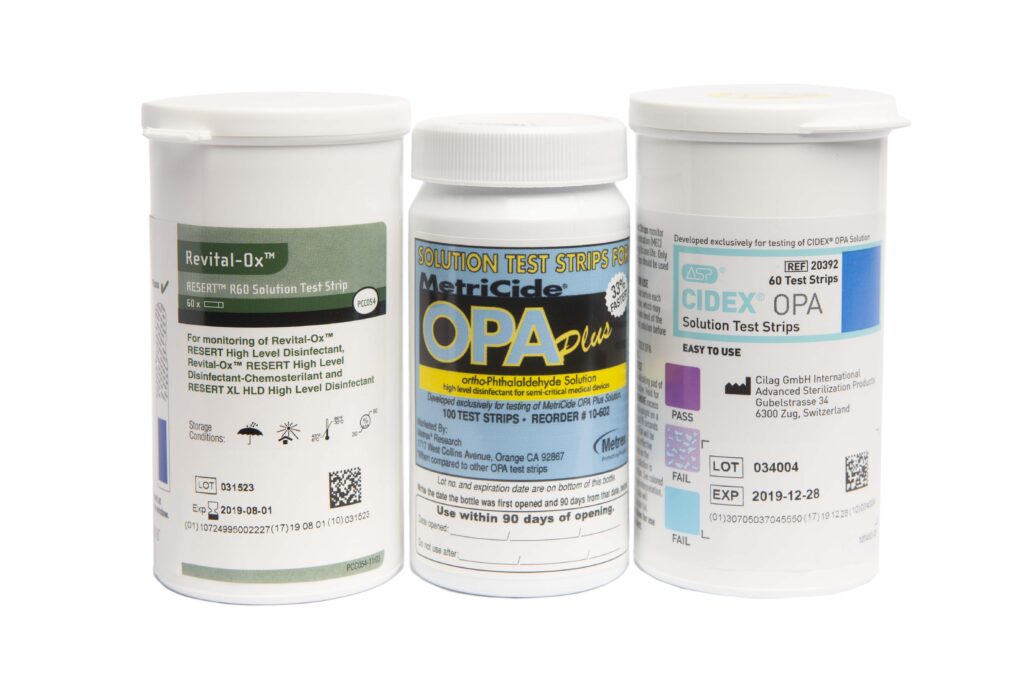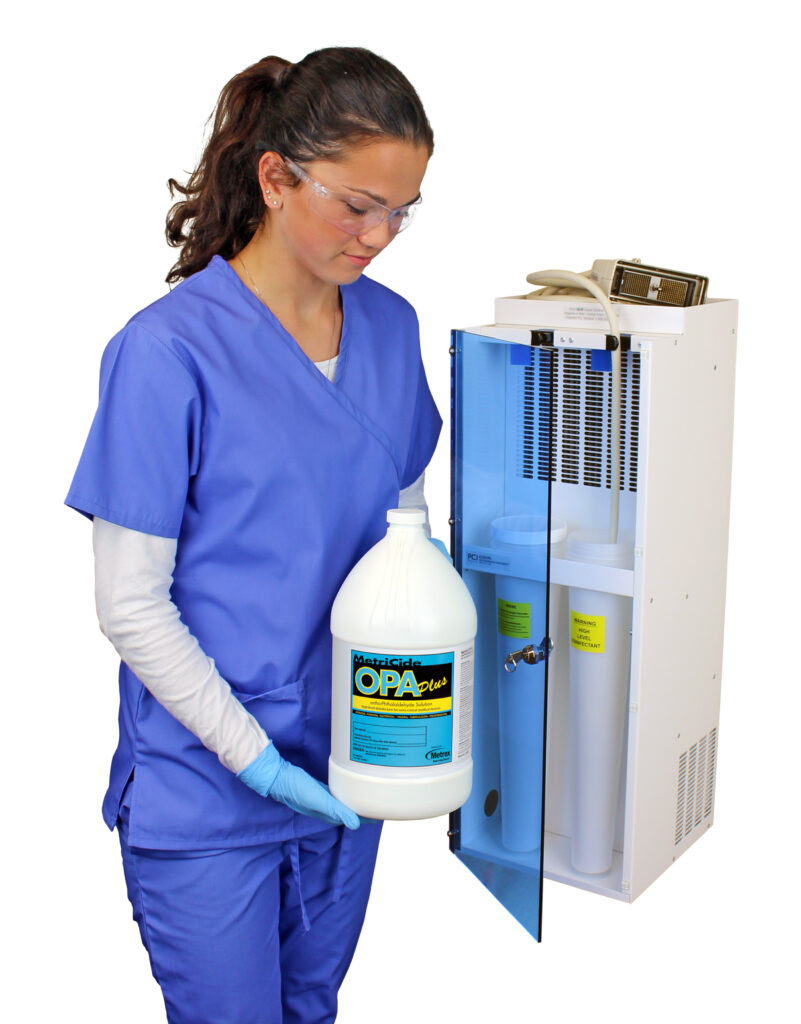Which High-Level Disinfectant Is Right For My Facility?

High-level disinfection is defined as the chemical method of killing all microorganisms in or on a medical instrument, except for a small number of bacterial spores.1 Typically utilized after a sem-critical medical device (i.e. any device that contacts intact mucous membranes or non-intact skin, such as an ultrasound probe) is handled during a medical procedure, high-level disinfection is used as a means of sanitizing the device of any potential contamination, and is considered to be a crucial step in most probe disinfection processes.2

During high-level disinfection, medical devices are immersed in a high-level disinfectant (HLD) solution, which serves to completely kill all vegetative bacteria, fungi, mycobacterium, and viruses on the device.3 There are various types of HLD solutions that healthcare workers can select from to clean their devices, with each solution offering distinct advantages and disadvantages, depending on the situation and type of transducer being disinfected.
High-Level Disinfectant Solutions
Hydrogen peroxide:
- mechanism of action: produces destructive hydroxyl free radicals that can attack membrane lipids, DNA, and other essential cell components 4
- immersion time: 30 minutes at 20°C 5
- reuse life: 21 days. 5
- shelf-life stability: 2 years 5
- advantages:3
- no activation required
- active against a wide range of microorganisms.
- no disposal issues
- no odor or irritation issues
- does not coagulate blood or fix tissues to surfaces
- disadvantages:3
- serious eye damage with excessive contact.
- material compatibility concerns (brass, zinc, copper, and nickel/silver plating), both cosmetic and functional.
CIVCO's UltrOx™ hydrogen peroxide solution is a reusable high-level disinfectant for processing semi-critical medical devices that are safe, ready-to-use, and fast-acting. With a quick 8-minute contact time at 20°C / 68°F and a reuse life of up to 21 days, UltrOx™ provides an efficient alternative to commonly used aldehyde solutions, requiring no extra ventilation and leaving zero toxic residues on devices, all while ensuring that your probes are receiving complete and thorough disinfection.
OPA:
- short for ortho-phthaladehyde
- currently the most commonly-used aldehyde for high-level disinfection 6
- mechanism of action: binds to membrane receptors due to cross-linkage and impairs the membrane functions, allowing the biocide to enter through the permeabilized membrane, where it interacts with intracellular reactive molecules, such as RNA 7
- immersion time: 12 minutes at 20°C and 5 minutes at 25°C 5
- reuse life: 14 days 5
- shelf-life stability: 2 years 5
- advantages: 3
- fast acting
- no activation required
- may be used in manual or automated preprocessors
- odor not significant
- excellent materials compatibility
- does not coagulate blood or fix tissues to surfaces
- disadvantages: 3
- stains skin, mucous membranes, clothing, and environmental surfaces
- can aggravate pre-existing bronchitis or asthma conditions
- slow sporicidal activity
- more expensive than glutaraldehyde
- potential irritant of eyes, skin, nose, and other tissues
- repeated exposure may result in hypersensitivity in patients with bladder cancer.
Substantial research has been conducted in recent years that examine the efficacy of OPA and hydrogen peroxide in neutralizing various notable pathogens and bacteria, including human papillomavirus (HPV), a virus that is highly contagious across various types of ultrasound probe surfaces. Two studies, in particular, have provided considerable insight into the solution's efficacy against the virus, which can be read here and here.
Peracetic acid:
- also referred to as "peroxyacetic acid" 8
- mechanism of action: denatures proteins, disrupts the cell wall permeability, and oxidizes sulfhydryl and sulfur bonds in proteins, enzymes, and other metabolites.
- immersion time: N/A 5
- reuse life: N/A (peracetic acid is single-use) 5
- shelf-life stability: 2 years 5
- advantages: 3
- lacks harmful decomposition products (i.e. acetic acid, water, oxygen, hydrogen peroxide)
- rapidly sporicidal
- environmentally friendly byproducts (acetic acid, O2, H20), leaving no residue.
- rapid sterilization cycle time (30-45 minutes)
- compatible with many materials and instruments.
- disadvantages: 3
- can corrode copper, brass, bronze, plain steel, and galvanized iron
- considered unstable, particularly when diluted
- more expensive
- can cause serious eye and skin damage with contact
Manual or Automated High-Level Disinfection?
Just as important as choosing which HLD solution to use when disinfecting your ultrasound transducer is also choosing which method of high-level disinfection to utilize.

When manually reprocessing an ultrasound probe or scope, it is important to account for proper ventilation, air filtration, and all soak time and rinsing requirements to ensure a safe and thorough probe disinfection process for your staff and patients.
CIVCO's GUS® Disinfection Soak Stations provide a safer way to manually reprocess most types and sizes of ultrasound probes and scopes. GUS Systems provide state-of-the-art filtration and advanced ventilation to create a more protected environment for clinicians and patients while helping customers meet all Joint Commission and OSHA standards. GUS stations are easy to operate and compatible with various disinfectants (OPA, glutaraldehyde, hydrogen peroxide). For more information on how GUS can help to streamline your probe disinfection, click here.
Meanwhile, high-level disinfection can also be conducted via automated means. Automated high-level disinfection refers to the process of performing high-level disinfection on ultrasound transducers via the use of an automated reprocessing system. Automated high-level disinfection devices offer an alternative to manual ultrasound probe disinfection processes and have been shown to improve patient and operator safety by preventing exposure to toxic chemicals, while also reducing the risk of operator error. 9
CIVCO's ASTRA® TEE Automated Probe Disinfection System is designed from the ground up to streamline your disinfection process, helping you to achieve workflow efficiency, significant savings, and a compliant workflow. ASTRA's automated data logging and consumable tracking remove the need for any manual logging, while its clear, easy-to-follow prompts guide you through the disinfection process, helping you to stay compliant with the Joint Commission standards while maximizing safety. Even better, ASTRA helps to reduce long-term operating costs with your choice of 4 reusable, industry-leading disinfectants, including UltrOx™ (hydrogen peroxide), Revital-Ox® RESERT® (hydrogen peroxide), Cidex® OPA, and Metricide™ OPA Plus. To learn more about how ASTRA can help you achieve optimized probe disinfection, click here.







